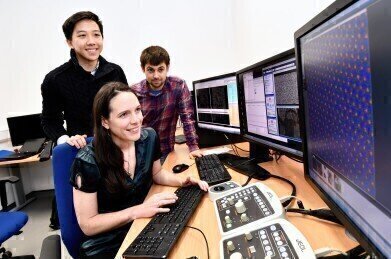-
 First users, Lan Nguyen, project leader Dr Sarah Haigh, and Dr Aiden Rooney using the ePSIC facility at Diamond Light Source.
First users, Lan Nguyen, project leader Dr Sarah Haigh, and Dr Aiden Rooney using the ePSIC facility at Diamond Light Source.
News & Views
First Users at ePSIC Investigate Semiconductor Properties
May 11 2017
Scientists from The National Graphene Institute at the University of Manchester, have been welcomed as the first users the of electron Physical Sciences Imaging Centre, (ePSIC), at Diamond Light Source. The centre, a result of a collaboration between the University of Oxford, industry partners Johnson Matthey and Diamond, offers atomic scale imaging at world-leading resolution.
“This helps us to realise a challenge put to me around 5 years ago,” said Professor Angus Kirkland, Science Director at ePSIC “which was to build on the synergies with Diamond and the ISIS Neutron and Muon Source to make the Harwell Science and Innovation campus a home to imaging across X-rays at Diamond, neutrons at ISIS and now electrons with ePSIC.”
The centre hosts two electron microscopes, one operated shared between the University of Oxford and Diamond, and one operated in conjunction with Johnson Matthey. “Our strategic objective has been to add value to the electron microscopy landscape and our design has ensured one of the most stable electron microscopes in Europe,” continued Professor Kirkland. “We’ve not replicated what other labs have done; as a result our equipment is capable at operating at very high resolutions – around 43 picometers – and at frame rates of up to 1,000 frames per second.”
“It’s very satisfying to see how new ideas for new experiments flow when collaborating with different scientific communities,” added Dr Cecilia Sanchez-Hanke, Operations Director at ePSIC. “These electron microscopes are an excellent complement to Diamond’s imaging beamlines with spatial resolutions in the nanoscale range, such as our X-ray Nanoprobe beamline (I14) and our scanning X-ray microscopy beamline (I08).”
The partnership with the University of Oxford sees Dr Christopher Allen from the university’s Maths, Physical and Life Sciences Division (MPLS) based at Diamond. “In addition to supporting users and keeping the microscope operating as well as it possibly can, I’m able to continue my work into low dimensional materials like graphene,” explained Dr Allen. “Our hope is that we can encourage people from outside the traditional electron microscopy community, who wouldn’t normally use such a technique, to exploit imaging techniques we can now offer here.”
“Collaborations between I14 and ePSIC are already in place and there’s interest in the community in the atomic resolution spectroscopy these machines will offer,” added Dr Sanchez-Hanke. “It’s fantastic to see the excitement growing.”
The first users, from the University of Manchester’s National Graphene Institute are investigating the properties of a two dimensional superconductor. “This sort of superconductor behaves in an unusual way and we think the promising properties are related to its atomic structure,” explained Dr Sarah Haigh, from the National Graphene Institute. “If we can understand this behaviour in these superconductors they could have many different benefits. For example, a sizeable chunk of the nation’s energy budget is lost between power plants and the consumer: superconductors offer a route to a more efficient national grid. Better superconductors would also allow us to develop improved medical imaging techniques.”
“There’s lots we don’t understand and this microscope really allows us to probe the fundamentals of how this superconducting material is behaving,” she continued. “It’s a very new material, so we don’t know the best conditions under which to investigate it. The wide range of energies this microscope operates at will hopefully allow us to determine those optimal conditions – then we can really understand how it’s working. It’s really very exciting to have access to this cutting edge facility.”
Users of ePSIC can apply for access to the electron microscopes in the same way they would for any other beamline at Diamond, through a well-established peer review process, or by performing proprietary research available through Diamond’s Industrial Liaison Office. “The next step is to develop even more techniques for our users to take advantage of, many of which will be new for the field of electron microscopy,” said Dr Allen. “These include using our fast electron detectors to study the atomic structure of our samples while we heat, cool or pass electrical currents through them.”
“The incorporation of these new high resolution electron microscopes into our suite of imaging beamlines will help us to achieve our goal of expanding the spatial resolution range in imaging we offer from microns up to the atomic level and beyond,” concluded Dr Sanchez-Hanke. “This is another element of Diamond’s efforts to maintain its place as a world-class facility for the next ten years and beyond.”
For more information about ePSIC, visit www.diamond.ac.uk
Digital Edition
Lab Asia 31.2 April 2024
April 2024
In This Edition Chromatography Articles - Approaches to troubleshooting an SPE method for the analysis of oligonucleotides (pt i) - High-precision liquid flow processes demand full fluidic c...
View all digital editions
Events
Apr 28 2024 Montreal, Quebec, Canada
May 05 2024 Seville, Spain
InformEx Zone at CPhl North America
May 07 2024 Pennsylvania, PA, USA
May 14 2024 Oklahoma City, OK, USA
May 15 2024 Birmingham, UK

















